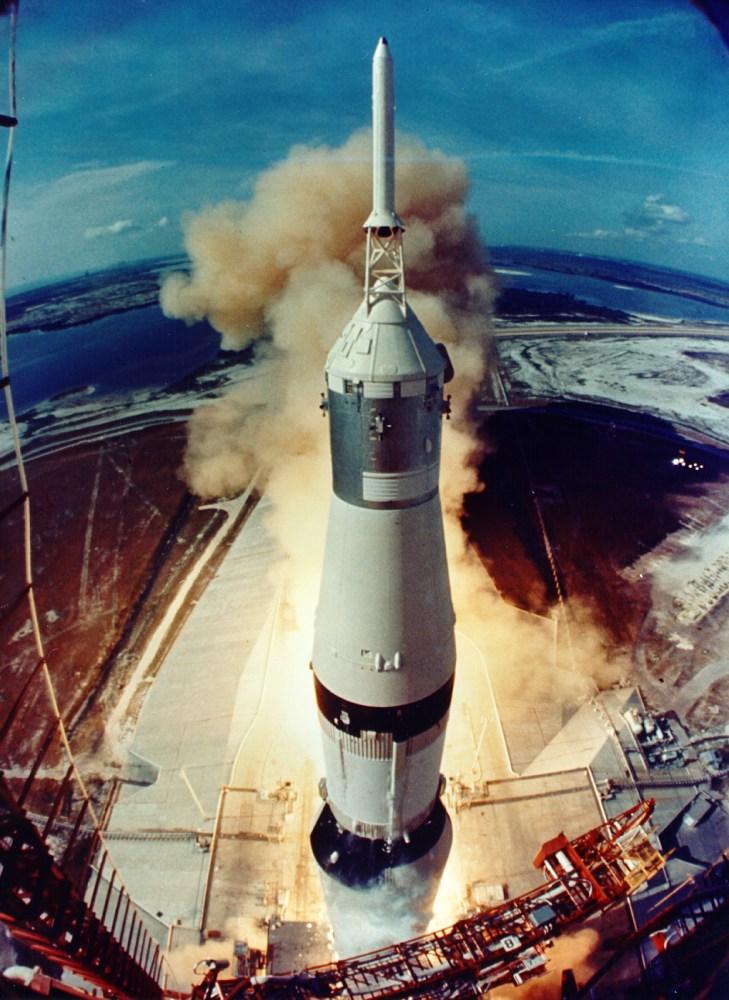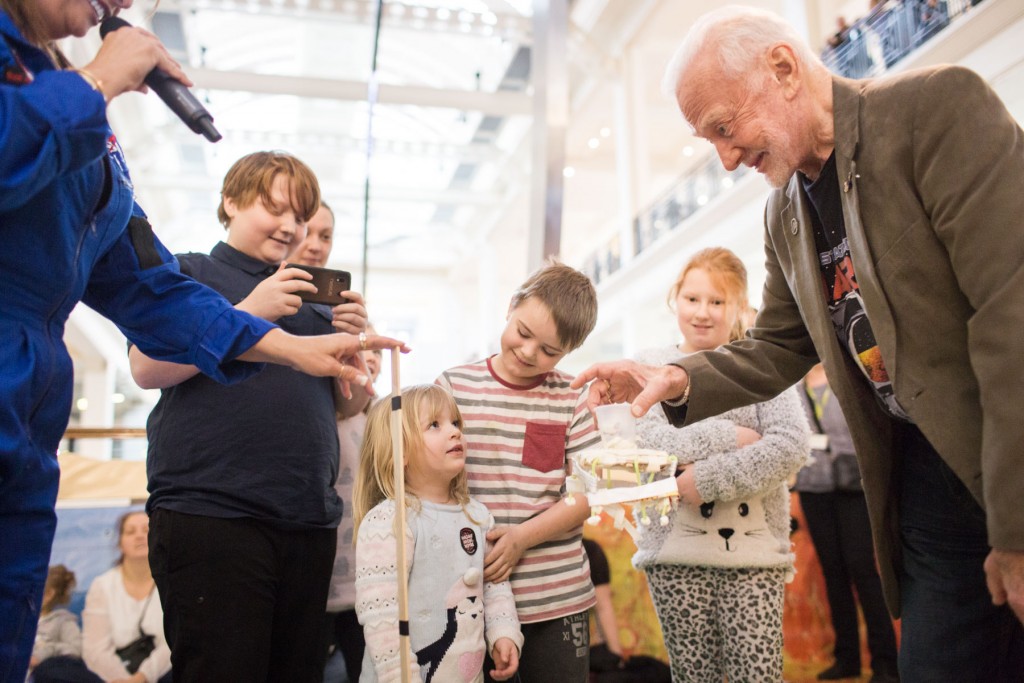Roger Highfield, Director of External Affairs, introduces a special Cosmonauts event with Buzz Aldrin and Professor Brian Cox
Mars has been the ultimate objective for five US presidents and getting there is ‘the easy part,’ Dr Buzz Aldrin said at a special IMAX Theatre event in the Science Museum today (28 February 2016).
The aim should be to ‘keep Mars occupied’, said Dr Aldrin, who made history on 20 July, 1969, when he became the first to land on another world, along with Neil Armstrong, in the ‘giant leap for mankind’ made by the Apollo 11 mission.
He was visiting the Museum today (28 February 2016) to help inspire the next generation of Mars explorers and discuss the next step to the red planet and beyond, at a special Q and A with the physicist and broadcaster, Prof Brian Cox, after which Dr Aldrin signed his latest books about Mars.
Dr Aldrin believes that mankind could touch down on the red planet by 2040 and estimates that the generation of children born around the year 2000 will be the first to make the long journey.
Cooperation, not competition, with other nations such as Russia, Japan and China, along with the European Space Agency, are the key to colonising Mars, according to Dr Aldrin, who has a vision of establishing a population of “several hundred” on Mars, a number that would be grown.
Competition ‘would make it very very messy’ and no one nation can do it alone. ‘We must come together’ he said.
A colony would also require a constant ‘cycling pathways’ to get people and supplies from the Earth to Mars. He has devised a master plan known as the “Aldrin Mars Cycler” – an arrangement of spacecraft with perpetual cycling orbits between Earth and Mars. ‘It gets more economical that way.’
Prof Stephen Hawking has hailed the Apollo 11 Moon landing as humanity’s greatest achievement , said Prof Cox, and today Dr Aldrin replied that it was ‘a bold step of conquest,’ not least because the commitment to go to the moon came when America had not even put a human in orbit.

In discussing the Apollo landing, Dr Aldrin admitted when it came the various launch systems under consideration, one key concern was ensuring that they beat Alexei Leonov to the moon, who was being trained for a landing by the Soviet Union in the mid-sixties in a single cosmonaut lander.
He added that the Soviets had developed many unmanned moon probes in their Luna programme, starting with an impact landing on the moon in 1959.
Prof Cox asked him how it felt to pilot a Saturn V launch vehicle at the lift off of Apollo 11. “You are not piloting, you are along for the ride,” Dr Aldrin explained, adding the Saturn V was ‘a great rocket.’
Apollo 11 was also remarkable because in previous missions, spacecraft were never abandoned by both members of the crew, as was the case with the Apollo 11 moon lander when both Armstrong and Aldrin stepped out onto the Moon’s surface.
With Armstrong, Dr Aldrin spent 21 hours on the lunar surface as fellow crewmember Michael Collins orbited overhead and they returned with 46 pounds of moon rocks.
He explained later, in response to a question from the audience, ‘An iPhone has more computing power than our spacecraft did in 1969 – I get a little resentful! Our computers did complicated manoeuvres. Do you think if I threw and iPhone up in the air that it would be able to make a star sighting or manoeuvre corrections?”
An estimated 600 million people – at that time, the world’s largest television audience in history – witnessed this unprecedented heroic endeavour. ‘It all worked out pretty good,’ he said.

That morning, Buzz Aldrin’s ShareSpace Foundation, a non-profit organisation which aims to inspire children in science, technology, engineering, arts and mathematics, had debuted its Giant Destination Mars Map in Britain at the Science Museum. The map was created with the help of NASA and Mars experts.
Children, starting with those from the charity Family Action Medway, gathered on the 25’ by 25’ map to build their own version of Mars landers using everyday objects with guidance from Aldrin and ShareSpace Executive Director Linn LeBlanc. One asked Aldrin how he went to the loo in space and he explained how he was the first to pee on the moon, using a Urine Collection Device on his spacesuit.
In the Science Museum, visitors can see the Apollo 10 command module, which was vital for preparations to land on the Moon, and a model of the ‘Eagle’ Apollo 11 moon lander, the Lunar Excursion Module, both of which were visited by Dr Aldrin today.
Dr Aldrin is an author of nine books including his New York Times best-selling autobiography ‘Magnificent Desolation’ and ‘Mission to Mars: My Vision for Space Exploration’ which outlines his plan to get us beyond the moon and on to Mars. He has also written illustrated children’s books, including ‘Welcome to Mars: Making a Home on the Red Planet’.
The event was one of a series to mark the museum’s landmark Cosmonauts: Birth of the Space Age exhibition, which ends on 13 March 2016. Both Brian Cox and Dr Buzz Aldrin have visited.
Born 20 January, 1930 in Montclair, New Jersey as Edwin Eugene Aldrin, Jr., he received his nickname “Buzz” when his little sister pronounced the word brother as “buzzer” and the shortened form took hold (he legally changed his name to Buzz in 1985). Dr Aldrin joined the Air Force and flew F86 Sabre Jets in 66 combat missions in Korea, shot down two MIG-15s, and was decorated with the Distinguished Flying Cross. He went on to earn his Doctorate of Science in Astronautics at MIT, where he wrote his thesis on Manned Orbital Rendezvous. This returned to haunt him after he was selected by NASA in 1963 and, being the first with a doctorate, he became known as “Dr Rendezvous.”
The docking and rendezvous techniques he devised for spacecraft in Earth and lunar orbit became critical to the success of the Gemini and Apollo programs, and are still used by astronauts today. He also talked today about how he pioneered underwater training techniques, as a substitute for zero gravity flights, to simulate spacewalking.

He told the IMAX audience about another first – the ‘space selfie’, taken when he noticed the position of the cameras during the Gemini 12 mission spacewalk in November 1966. ‘It turned out pretty good,’ said Dr Aldrin. Improving the lighting would have meant moving the Sun or orbit, he joked.
Dr Aldrin was interviewed by Professor Brian Cox, Advanced Fellow of particle physics in the School of Physics and Astronomy at the University of Manchester, Royal Society Professor for Public Engagement in Science and a presenter of numerous science programmes including BBC2’s Stargazing Live.
One comment on “Dr Buzz Aldrin on Apollo, ‘space selfies’ and how to colonise Mars”
Comments are closed.
We look forward to seeing the talk on the video on 29th February.